Take Home Assignment N 135: Nursing and Healthcare in Canada Analysis
VerifiedAdded on 2022/11/13
|7
|1821
|77
Homework Assignment
AI Summary
This assignment analyzes the challenges faced by the Canadian healthcare system in the 21st century, focusing on nursing shortages and the impact on healthcare delivery. It discusses the factors contributing to the nursing shortage, such as an aging workforce and limited graduates, and the resulting issues with healthcare service provision. The assignment also examines the role of internationally educated nurses (IENs) in addressing these shortages, outlining both the advantages, such as experience and cultural diversity, and the drawbacks, including communication barriers and integration challenges. Furthermore, it touches upon the ethical considerations involved in recruiting IENs. The paper references various studies and reports to support its arguments, providing a comprehensive overview of the Canadian healthcare landscape.
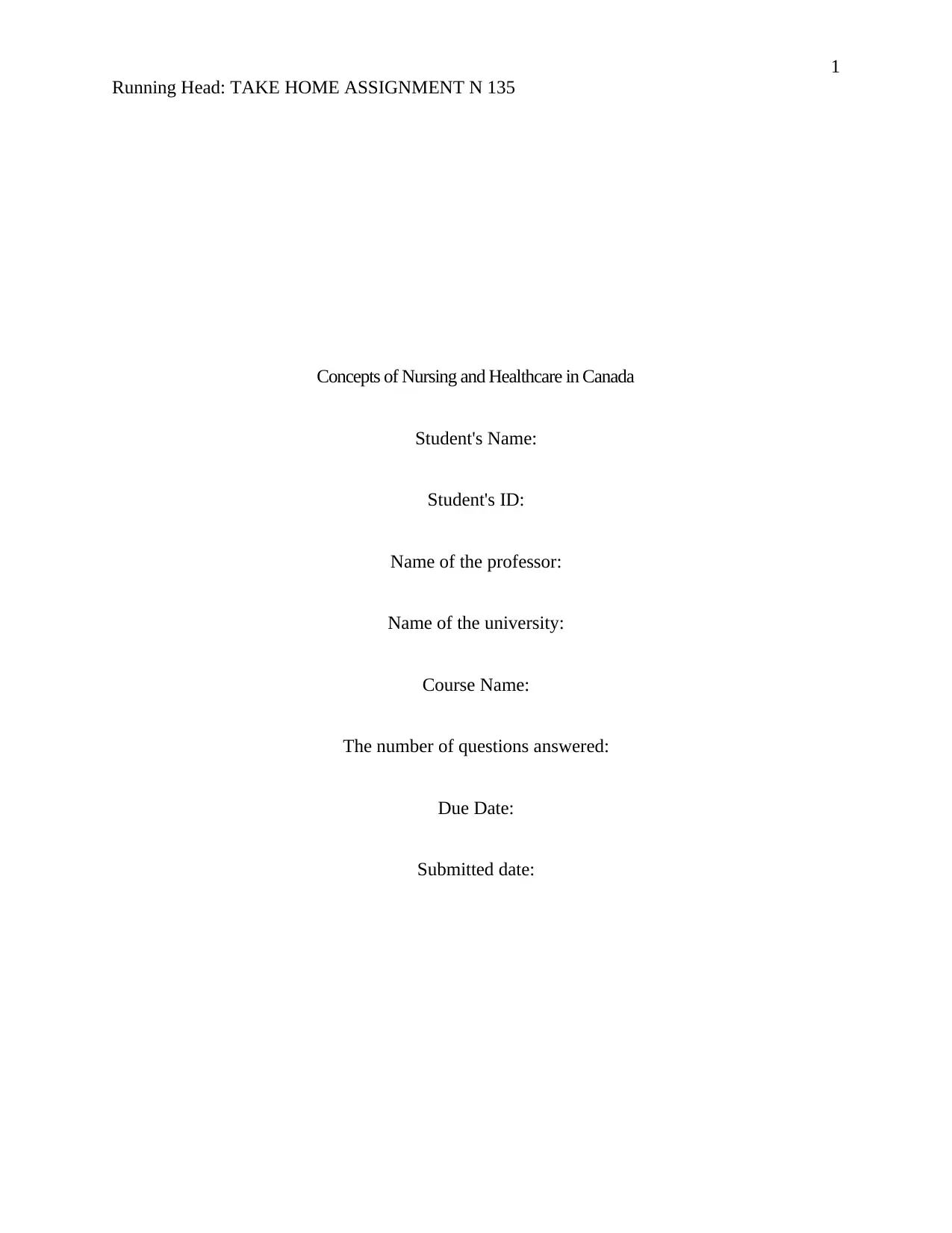
1
Running Head: TAKE HOME ASSIGNMENT N 135
Concepts of Nursing and Healthcare in Canada
Student's Name:
Student's ID:
Name of the professor:
Name of the university:
Course Name:
The number of questions answered:
Due Date:
Submitted date:
Running Head: TAKE HOME ASSIGNMENT N 135
Concepts of Nursing and Healthcare in Canada
Student's Name:
Student's ID:
Name of the professor:
Name of the university:
Course Name:
The number of questions answered:
Due Date:
Submitted date:
Paraphrase This Document
Need a fresh take? Get an instant paraphrase of this document with our AI Paraphraser
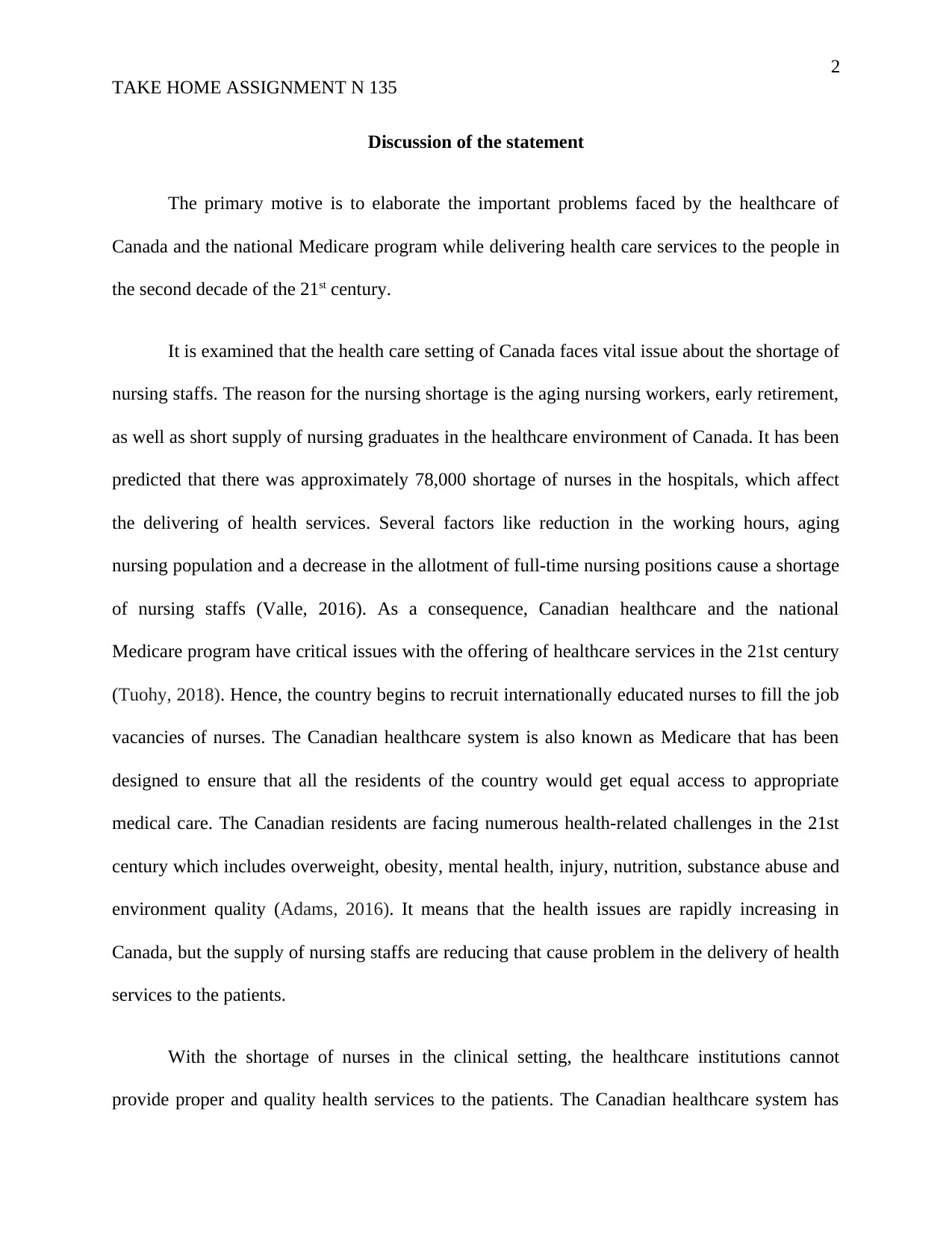
2
TAKE HOME ASSIGNMENT N 135
Discussion of the statement
The primary motive is to elaborate the important problems faced by the healthcare of
Canada and the national Medicare program while delivering health care services to the people in
the second decade of the 21st century.
It is examined that the health care setting of Canada faces vital issue about the shortage of
nursing staffs. The reason for the nursing shortage is the aging nursing workers, early retirement,
as well as short supply of nursing graduates in the healthcare environment of Canada. It has been
predicted that there was approximately 78,000 shortage of nurses in the hospitals, which affect
the delivering of health services. Several factors like reduction in the working hours, aging
nursing population and a decrease in the allotment of full-time nursing positions cause a shortage
of nursing staffs (Valle, 2016). As a consequence, Canadian healthcare and the national
Medicare program have critical issues with the offering of healthcare services in the 21st century
(Tuohy, 2018). Hence, the country begins to recruit internationally educated nurses to fill the job
vacancies of nurses. The Canadian healthcare system is also known as Medicare that has been
designed to ensure that all the residents of the country would get equal access to appropriate
medical care. The Canadian residents are facing numerous health-related challenges in the 21st
century which includes overweight, obesity, mental health, injury, nutrition, substance abuse and
environment quality (Adams, 2016). It means that the health issues are rapidly increasing in
Canada, but the supply of nursing staffs are reducing that cause problem in the delivery of health
services to the patients.
With the shortage of nurses in the clinical setting, the healthcare institutions cannot
provide proper and quality health services to the patients. The Canadian healthcare system has
TAKE HOME ASSIGNMENT N 135
Discussion of the statement
The primary motive is to elaborate the important problems faced by the healthcare of
Canada and the national Medicare program while delivering health care services to the people in
the second decade of the 21st century.
It is examined that the health care setting of Canada faces vital issue about the shortage of
nursing staffs. The reason for the nursing shortage is the aging nursing workers, early retirement,
as well as short supply of nursing graduates in the healthcare environment of Canada. It has been
predicted that there was approximately 78,000 shortage of nurses in the hospitals, which affect
the delivering of health services. Several factors like reduction in the working hours, aging
nursing population and a decrease in the allotment of full-time nursing positions cause a shortage
of nursing staffs (Valle, 2016). As a consequence, Canadian healthcare and the national
Medicare program have critical issues with the offering of healthcare services in the 21st century
(Tuohy, 2018). Hence, the country begins to recruit internationally educated nurses to fill the job
vacancies of nurses. The Canadian healthcare system is also known as Medicare that has been
designed to ensure that all the residents of the country would get equal access to appropriate
medical care. The Canadian residents are facing numerous health-related challenges in the 21st
century which includes overweight, obesity, mental health, injury, nutrition, substance abuse and
environment quality (Adams, 2016). It means that the health issues are rapidly increasing in
Canada, but the supply of nursing staffs are reducing that cause problem in the delivery of health
services to the patients.
With the shortage of nurses in the clinical setting, the healthcare institutions cannot
provide proper and quality health services to the patients. The Canadian healthcare system has
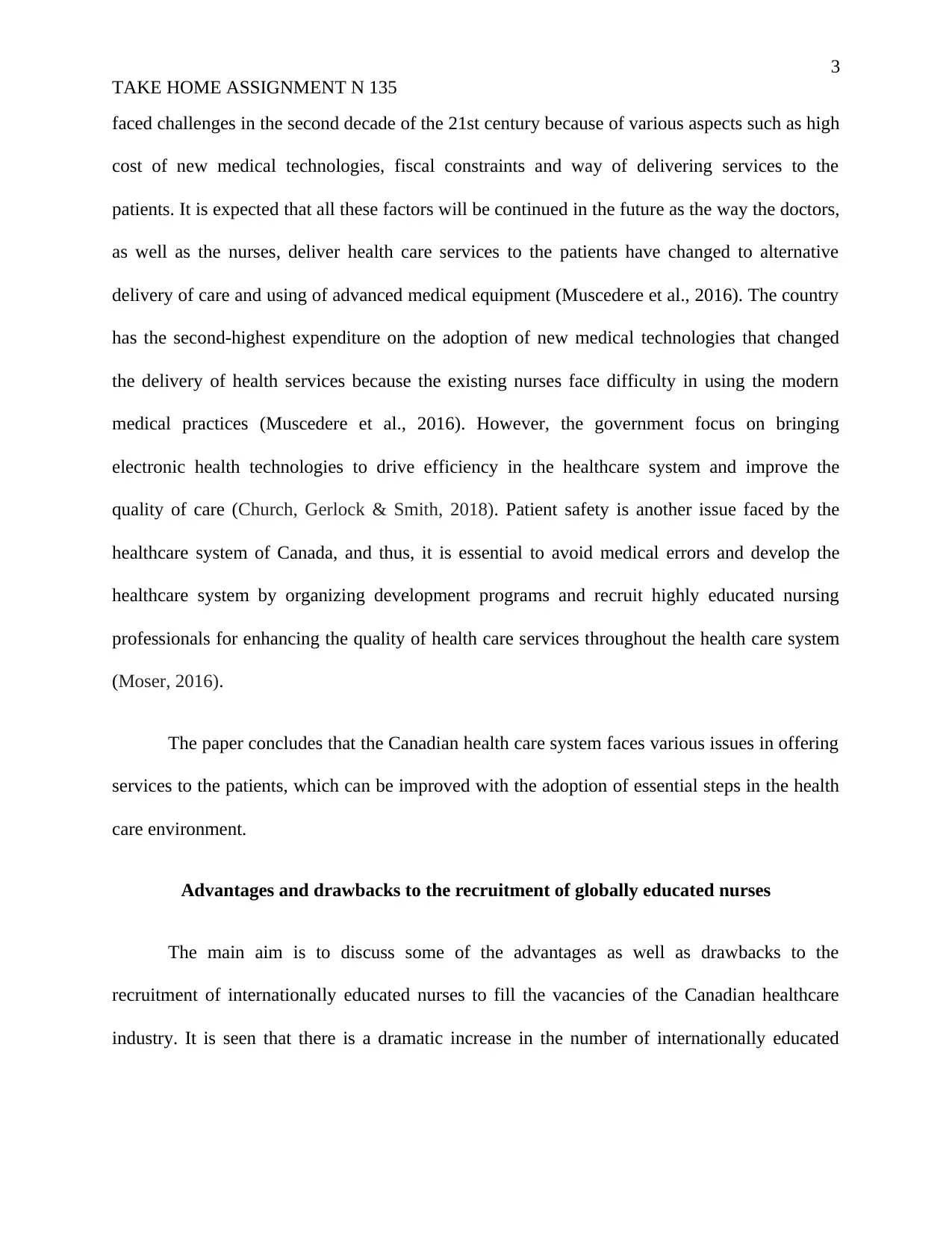
3
TAKE HOME ASSIGNMENT N 135
faced challenges in the second decade of the 21st century because of various aspects such as high
cost of new medical technologies, fiscal constraints and way of delivering services to the
patients. It is expected that all these factors will be continued in the future as the way the doctors,
as well as the nurses, deliver health care services to the patients have changed to alternative
delivery of care and using of advanced medical equipment (Muscedere et al., 2016). The country
has the second-highest expenditure on the adoption of new medical technologies that changed
the delivery of health services because the existing nurses face difficulty in using the modern
medical practices (Muscedere et al., 2016). However, the government focus on bringing
electronic health technologies to drive efficiency in the healthcare system and improve the
quality of care (Church, Gerlock & Smith, 2018). Patient safety is another issue faced by the
healthcare system of Canada, and thus, it is essential to avoid medical errors and develop the
healthcare system by organizing development programs and recruit highly educated nursing
professionals for enhancing the quality of health care services throughout the health care system
(Moser, 2016).
The paper concludes that the Canadian health care system faces various issues in offering
services to the patients, which can be improved with the adoption of essential steps in the health
care environment.
Advantages and drawbacks to the recruitment of globally educated nurses
The main aim is to discuss some of the advantages as well as drawbacks to the
recruitment of internationally educated nurses to fill the vacancies of the Canadian healthcare
industry. It is seen that there is a dramatic increase in the number of internationally educated
TAKE HOME ASSIGNMENT N 135
faced challenges in the second decade of the 21st century because of various aspects such as high
cost of new medical technologies, fiscal constraints and way of delivering services to the
patients. It is expected that all these factors will be continued in the future as the way the doctors,
as well as the nurses, deliver health care services to the patients have changed to alternative
delivery of care and using of advanced medical equipment (Muscedere et al., 2016). The country
has the second-highest expenditure on the adoption of new medical technologies that changed
the delivery of health services because the existing nurses face difficulty in using the modern
medical practices (Muscedere et al., 2016). However, the government focus on bringing
electronic health technologies to drive efficiency in the healthcare system and improve the
quality of care (Church, Gerlock & Smith, 2018). Patient safety is another issue faced by the
healthcare system of Canada, and thus, it is essential to avoid medical errors and develop the
healthcare system by organizing development programs and recruit highly educated nursing
professionals for enhancing the quality of health care services throughout the health care system
(Moser, 2016).
The paper concludes that the Canadian health care system faces various issues in offering
services to the patients, which can be improved with the adoption of essential steps in the health
care environment.
Advantages and drawbacks to the recruitment of globally educated nurses
The main aim is to discuss some of the advantages as well as drawbacks to the
recruitment of internationally educated nurses to fill the vacancies of the Canadian healthcare
industry. It is seen that there is a dramatic increase in the number of internationally educated
⊘ This is a preview!⊘
Do you want full access?
Subscribe today to unlock all pages.

Trusted by 1+ million students worldwide
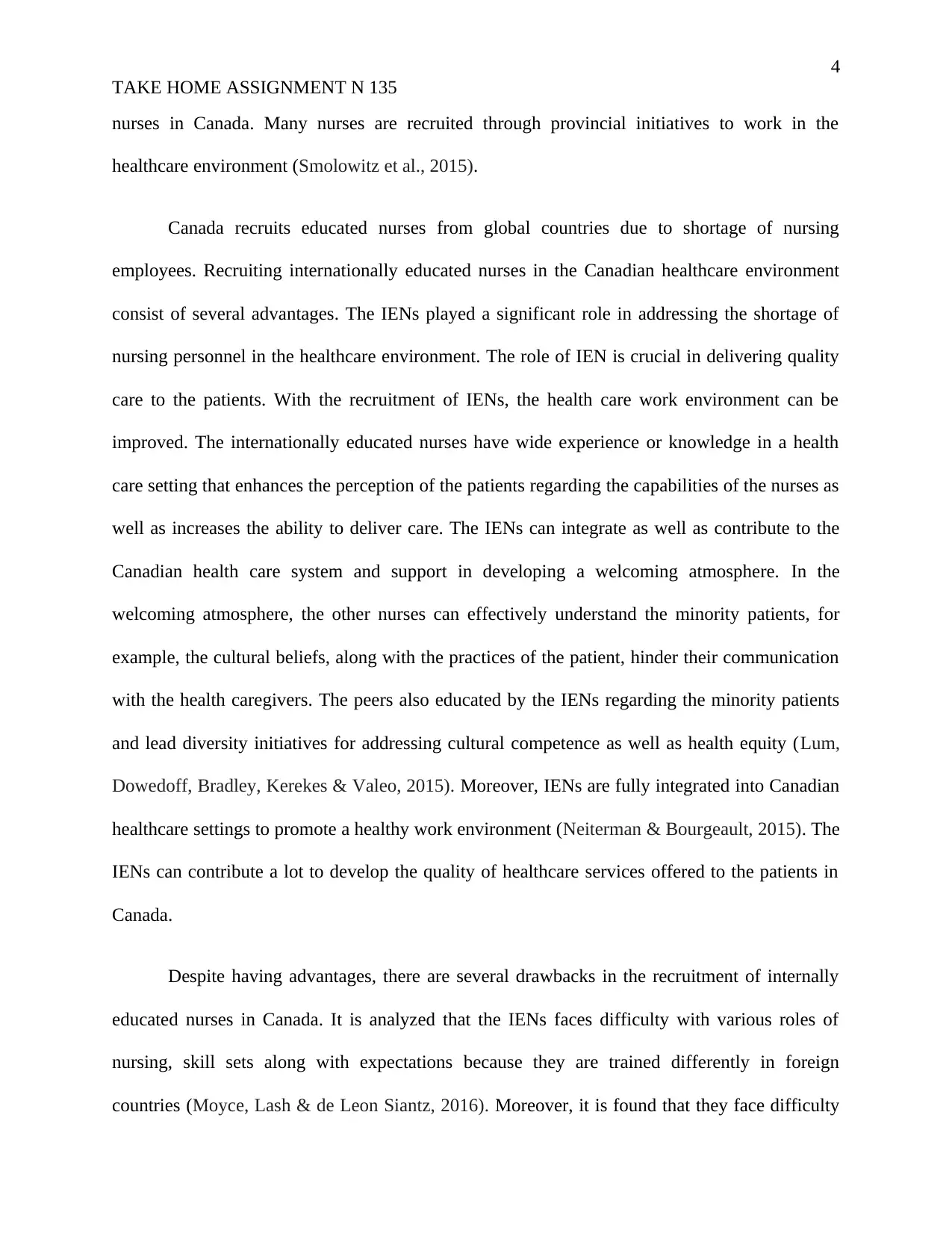
4
TAKE HOME ASSIGNMENT N 135
nurses in Canada. Many nurses are recruited through provincial initiatives to work in the
healthcare environment (Smolowitz et al., 2015).
Canada recruits educated nurses from global countries due to shortage of nursing
employees. Recruiting internationally educated nurses in the Canadian healthcare environment
consist of several advantages. The IENs played a significant role in addressing the shortage of
nursing personnel in the healthcare environment. The role of IEN is crucial in delivering quality
care to the patients. With the recruitment of IENs, the health care work environment can be
improved. The internationally educated nurses have wide experience or knowledge in a health
care setting that enhances the perception of the patients regarding the capabilities of the nurses as
well as increases the ability to deliver care. The IENs can integrate as well as contribute to the
Canadian health care system and support in developing a welcoming atmosphere. In the
welcoming atmosphere, the other nurses can effectively understand the minority patients, for
example, the cultural beliefs, along with the practices of the patient, hinder their communication
with the health caregivers. The peers also educated by the IENs regarding the minority patients
and lead diversity initiatives for addressing cultural competence as well as health equity (Lum,
Dowedoff, Bradley, Kerekes & Valeo, 2015). Moreover, IENs are fully integrated into Canadian
healthcare settings to promote a healthy work environment (Neiterman & Bourgeault, 2015). The
IENs can contribute a lot to develop the quality of healthcare services offered to the patients in
Canada.
Despite having advantages, there are several drawbacks in the recruitment of internally
educated nurses in Canada. It is analyzed that the IENs faces difficulty with various roles of
nursing, skill sets along with expectations because they are trained differently in foreign
countries (Moyce, Lash & de Leon Siantz, 2016). Moreover, it is found that they face difficulty
TAKE HOME ASSIGNMENT N 135
nurses in Canada. Many nurses are recruited through provincial initiatives to work in the
healthcare environment (Smolowitz et al., 2015).
Canada recruits educated nurses from global countries due to shortage of nursing
employees. Recruiting internationally educated nurses in the Canadian healthcare environment
consist of several advantages. The IENs played a significant role in addressing the shortage of
nursing personnel in the healthcare environment. The role of IEN is crucial in delivering quality
care to the patients. With the recruitment of IENs, the health care work environment can be
improved. The internationally educated nurses have wide experience or knowledge in a health
care setting that enhances the perception of the patients regarding the capabilities of the nurses as
well as increases the ability to deliver care. The IENs can integrate as well as contribute to the
Canadian health care system and support in developing a welcoming atmosphere. In the
welcoming atmosphere, the other nurses can effectively understand the minority patients, for
example, the cultural beliefs, along with the practices of the patient, hinder their communication
with the health caregivers. The peers also educated by the IENs regarding the minority patients
and lead diversity initiatives for addressing cultural competence as well as health equity (Lum,
Dowedoff, Bradley, Kerekes & Valeo, 2015). Moreover, IENs are fully integrated into Canadian
healthcare settings to promote a healthy work environment (Neiterman & Bourgeault, 2015). The
IENs can contribute a lot to develop the quality of healthcare services offered to the patients in
Canada.
Despite having advantages, there are several drawbacks in the recruitment of internally
educated nurses in Canada. It is analyzed that the IENs faces difficulty with various roles of
nursing, skill sets along with expectations because they are trained differently in foreign
countries (Moyce, Lash & de Leon Siantz, 2016). Moreover, it is found that they face difficulty
Paraphrase This Document
Need a fresh take? Get an instant paraphrase of this document with our AI Paraphraser

5
TAKE HOME ASSIGNMENT N 135
in practice that ranges from complicated dressing change to taking orders on the telephone.
Besides this, the IENs face various communication challenges within the workplace that a hinder
their workplace integration, such as they are unable to understand certain words about the culture
of Canada. The communication obstacles obstruct the positive relationship between the nurse
and patient, along with hinder the quality care provision in the entire unit. The communication
challenge can also occur because of the unfamiliarity of nursing practices in the Canadian health
care environment. The IENs also face significant structural challenges like discrimination or
racism in the clinical setting and cultural challenges consists of the differences in the health care
system. Furthermore, the IENs confronted vital challenges from employers and colleagues when
integrating to clinical practice, which involves lack of confidence and feels like outsiders. The
IENs wanted to be considered as experienced as well as knowledgeable nurses (Pung & Goh,
2017).The ethics involved in this is the development of Canadian ethical approach, which
requires workforce planning and self-sufficiency (Shaffer, Bakhshi, Dutka & Phillips, 2016).
The paper concludes that IENs played an essential role in improving the quality of health
services in Canada and reduce the shortage of nursing workforce in the healthcare environment.
However, IENs face several cultural and structural challenges while integrating to the clinical
setting.
TAKE HOME ASSIGNMENT N 135
in practice that ranges from complicated dressing change to taking orders on the telephone.
Besides this, the IENs face various communication challenges within the workplace that a hinder
their workplace integration, such as they are unable to understand certain words about the culture
of Canada. The communication obstacles obstruct the positive relationship between the nurse
and patient, along with hinder the quality care provision in the entire unit. The communication
challenge can also occur because of the unfamiliarity of nursing practices in the Canadian health
care environment. The IENs also face significant structural challenges like discrimination or
racism in the clinical setting and cultural challenges consists of the differences in the health care
system. Furthermore, the IENs confronted vital challenges from employers and colleagues when
integrating to clinical practice, which involves lack of confidence and feels like outsiders. The
IENs wanted to be considered as experienced as well as knowledgeable nurses (Pung & Goh,
2017).The ethics involved in this is the development of Canadian ethical approach, which
requires workforce planning and self-sufficiency (Shaffer, Bakhshi, Dutka & Phillips, 2016).
The paper concludes that IENs played an essential role in improving the quality of health
services in Canada and reduce the shortage of nursing workforce in the healthcare environment.
However, IENs face several cultural and structural challenges while integrating to the clinical
setting.
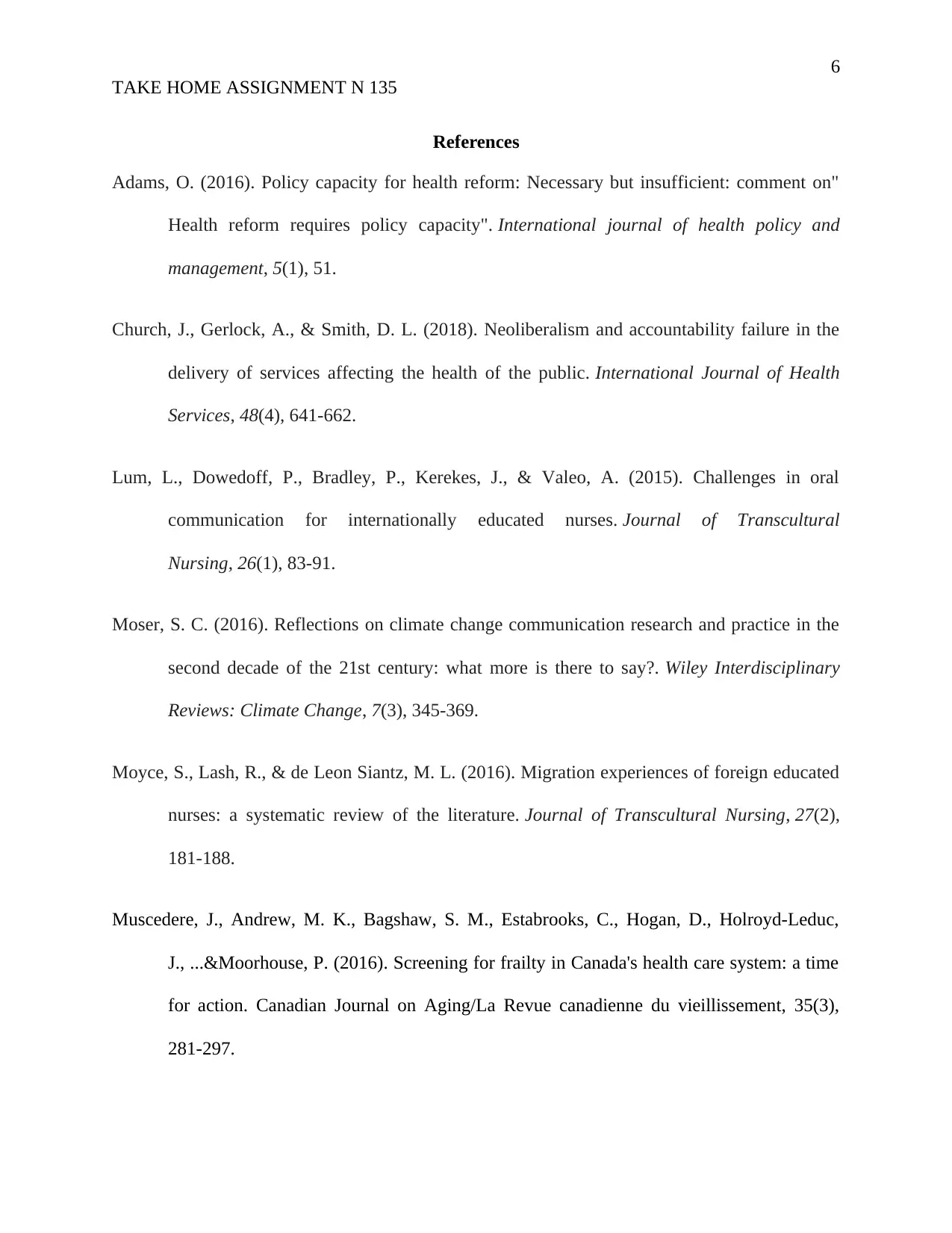
6
TAKE HOME ASSIGNMENT N 135
References
Adams, O. (2016). Policy capacity for health reform: Necessary but insufficient: comment on"
Health reform requires policy capacity". International journal of health policy and
management, 5(1), 51.
Church, J., Gerlock, A., & Smith, D. L. (2018). Neoliberalism and accountability failure in the
delivery of services affecting the health of the public. International Journal of Health
Services, 48(4), 641-662.
Lum, L., Dowedoff, P., Bradley, P., Kerekes, J., & Valeo, A. (2015). Challenges in oral
communication for internationally educated nurses. Journal of Transcultural
Nursing, 26(1), 83-91.
Moser, S. C. (2016). Reflections on climate change communication research and practice in the
second decade of the 21st century: what more is there to say?. Wiley Interdisciplinary
Reviews: Climate Change, 7(3), 345-369.
Moyce, S., Lash, R., & de Leon Siantz, M. L. (2016). Migration experiences of foreign educated
nurses: a systematic review of the literature. Journal of Transcultural Nursing, 27(2),
181-188.
Muscedere, J., Andrew, M. K., Bagshaw, S. M., Estabrooks, C., Hogan, D., Holroyd-Leduc,
J., ...&Moorhouse, P. (2016). Screening for frailty in Canada's health care system: a time
for action. Canadian Journal on Aging/La Revue canadienne du vieillissement, 35(3),
281-297.
TAKE HOME ASSIGNMENT N 135
References
Adams, O. (2016). Policy capacity for health reform: Necessary but insufficient: comment on"
Health reform requires policy capacity". International journal of health policy and
management, 5(1), 51.
Church, J., Gerlock, A., & Smith, D. L. (2018). Neoliberalism and accountability failure in the
delivery of services affecting the health of the public. International Journal of Health
Services, 48(4), 641-662.
Lum, L., Dowedoff, P., Bradley, P., Kerekes, J., & Valeo, A. (2015). Challenges in oral
communication for internationally educated nurses. Journal of Transcultural
Nursing, 26(1), 83-91.
Moser, S. C. (2016). Reflections on climate change communication research and practice in the
second decade of the 21st century: what more is there to say?. Wiley Interdisciplinary
Reviews: Climate Change, 7(3), 345-369.
Moyce, S., Lash, R., & de Leon Siantz, M. L. (2016). Migration experiences of foreign educated
nurses: a systematic review of the literature. Journal of Transcultural Nursing, 27(2),
181-188.
Muscedere, J., Andrew, M. K., Bagshaw, S. M., Estabrooks, C., Hogan, D., Holroyd-Leduc,
J., ...&Moorhouse, P. (2016). Screening for frailty in Canada's health care system: a time
for action. Canadian Journal on Aging/La Revue canadienne du vieillissement, 35(3),
281-297.
⊘ This is a preview!⊘
Do you want full access?
Subscribe today to unlock all pages.

Trusted by 1+ million students worldwide

7
TAKE HOME ASSIGNMENT N 135
Neiterman, E., & Bourgeault, I. L. (2015). Professional integration as a process of professional
resocialization: Internationally educated health professionals in Canada. Social science &
medicine, 131, 74-81.
Pung, L. X., & Goh, Y. S. (2017). Challenges faced by international nurses when migrating: an
integrative literature review. International nursing review, 64(1), 146-165.
Shaffer, F. A., Bakhshi, M., Dutka, J. T., & Phillips, J. (2016). Code for ethical international
recruitment practices: the CGFNS alliance case study. Human resources for
health, 14(1), 31.
Smolowitz, J., Speakman, E., Wojnar, D., Whelan, E. M., Ulrich, S., Hayes, C., & Wood, L.
(2015). Role of the registered nurse in primary health care: meeting health care needs in
the 21st century. Nursing Outlook, 63(2), 130-136.
Tuohy, C. H. (2018). What's Canadian about Medicare? A Comparative Perspective on Health
Policy. Healthcare Policy, 13(4), 11.
Valle, V. M. (2016). An Assessment of Canada's Healthcare System Weighing Achievements
and Challenges. Norteamérica, 11(2), 193-218.
TAKE HOME ASSIGNMENT N 135
Neiterman, E., & Bourgeault, I. L. (2015). Professional integration as a process of professional
resocialization: Internationally educated health professionals in Canada. Social science &
medicine, 131, 74-81.
Pung, L. X., & Goh, Y. S. (2017). Challenges faced by international nurses when migrating: an
integrative literature review. International nursing review, 64(1), 146-165.
Shaffer, F. A., Bakhshi, M., Dutka, J. T., & Phillips, J. (2016). Code for ethical international
recruitment practices: the CGFNS alliance case study. Human resources for
health, 14(1), 31.
Smolowitz, J., Speakman, E., Wojnar, D., Whelan, E. M., Ulrich, S., Hayes, C., & Wood, L.
(2015). Role of the registered nurse in primary health care: meeting health care needs in
the 21st century. Nursing Outlook, 63(2), 130-136.
Tuohy, C. H. (2018). What's Canadian about Medicare? A Comparative Perspective on Health
Policy. Healthcare Policy, 13(4), 11.
Valle, V. M. (2016). An Assessment of Canada's Healthcare System Weighing Achievements
and Challenges. Norteamérica, 11(2), 193-218.
1 out of 7
Related Documents
Your All-in-One AI-Powered Toolkit for Academic Success.
+13062052269
info@desklib.com
Available 24*7 on WhatsApp / Email
![[object Object]](/_next/static/media/star-bottom.7253800d.svg)
Unlock your academic potential
Copyright © 2020–2025 A2Z Services. All Rights Reserved. Developed and managed by ZUCOL.





